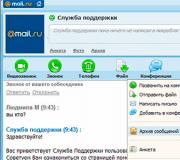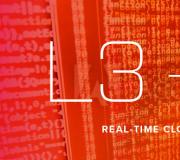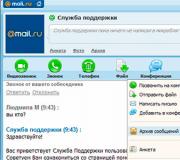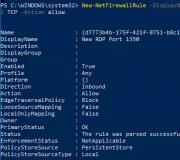How to put a dash in Word. How to make an em dash in Word
When typing text documents, it is often necessary to make an em dash. But there is no key on the keyboard that is responsible for this character. Therefore, many users do not know how to do this.
In this article we will look at 4 methods that can be used to insert an em dash into a Word document. Moreover, these methods are equally relevant both for the new Word 2007, 2010, 2013 and 2016, and for the old Word 2003.
Method No. 1. Using the key combination CTRL+ALT+minus.
Perhaps the simplest and most reliable way to make an em dash in Word is the key combination CTRL+ALT+minus. Using this key combination is very simple. Place the cursor in the place where you want to make an em dash, hold down the CTRL and ALT keys, and click on the “minus” button on the additional key block (on the right side of the keyboard). As a result, an em dash will be placed in the place you select.
If you need to insert not an em dash, but an em dash, then use the same key combination, only without ALT. That is, simply press CTRL + “minus” on the additional key block.
Method No. 2. Using the ALT+X key combination.
We have already talked about the ALT+X key combination in. But, this key combination can also be used to insert an em dash. To do this, enter the number “2014” in the place where the em dash should be, and then press the combination ALT+X. As a result, the number “2014” will disappear and an em dash will appear in its place.

If you need to make a shorter dash or hyphen, then instead of “2014” use the number “2013” or “2012”.
Method number 3. Using the ALT key.
Another option is to enter the character code while holding down the ALT key. To do this, place the cursor in the place where you would like to make an em dash, then hold down the ALT key and, without releasing it, enter the number “0151” on the additional key block (right side of the keyboard).
The advantage of this method is that it works not only in Word, but also in many other text editors.
Method number 4. Inserting an em dash manually.
The slowest and most difficult way is to insert an em dash manually. In Word 2007, 2010, 2013 and 2016, to do this, go to the “Insert” tab, click on the “Symbol” button and select the “More Symbols” option.

In Word 2003, to do this, open the “Insert” menu and select “Symbol”.

After this, a window will open with a list of all available symbols. Here you need to go to the “Special Characters” tab.

Then select the em dash and click on the “Insert” button.

This way you will make an em dash at the point in the Word document where your cursor was placed.
The question often arises when writing any articles or coursework, how to put a dash in Word or in any text editor. Everyone knows where the hyphen is, which is why it is used very often. Although there are no specific rules on this, it is still better to use a dash.
Turns out, there are 3 different types of dashes(long (-), medium (–) and “electronic” (-)) and at least 5 ways to insert them. In this article we will analyze not only situations for the Microsoft Word program, but also some methods can be applied in any text or HTML document.
Five different insertion methods - choose the one that suits you best
1. AutoCorrect in Word.
By default, the Microsoft Office Word program replaces a hyphen with a dash in the following situation: you type, for example, the following text “The verb is” and at the moment when you put a space after the word “this”, the hyphen will be replaced with a dash. That is, it will turn out: “The verb is.”
Autocorrect occurs when a hyphen has a space on either side, but if it is just a word where it is used, such as the word “somewhere,” then, of course, autocorrect will not work.
2. Use of hexadecimal codes.
If auto-replacement does not occur, then you can add a dash yourself using the typed numbers and key combinations.
In Word, simply type the number 2014 and press the key combination alt + x (x). The number 2014 will be replaced with an em dash. The number 2013 will be replaced by a shorter dash, and 2012 by an even smaller one.
3. A method for inserting dashes for any text editor.
Hold down the Alt key and type the numbers 0151 using the numeric keypad, release the Alt key. An em dash will appear in the place where you placed the cursor.
This method is suitable even if you are typing text not in Microsoft Word, but in any html editor.
4. Using hot keys.
If you have an additional “numeric” keyboard on your keyboard, then you can press the key combination Ctrl and “-” (Ctrl and minus sign) or the key combination ctrl + alt + “-” (capital dash).
5. Through the “Insert Symbol” menu.
Go to the “Insert” menu in Word

On the right we find the “Symbol” button

By clicking on it, a tab will appear on which you need to select “Other symbols”

A window will open with many different symbols

In order not to look for a dash among them, you can simply go to the “Special characters” tab. Select the em dash there, click “insert” and it will be placed in your document.

As it turns out, everything is very simple. We hope that this article will help you write your texts even more correctly.
Most PC users work with text editors. Each of them has its own specific style and intensity of use. Some people need a competent literary text, while others simply convey thoughts. Let us immediately note that in Word, to enter a hyphen, either several keys are used, or automatic settings for inserting an em dash are used. When using a sign occasionally, it is more convenient to use a keyboard shortcut. If it is used frequently to replace something, then it is better to configure automatic insertion. There are at least five ways to insert an em dash in Word.
First way
It involves using keys. The user simply presses the keyboard button with the desired letter or symbol. To quickly carry out various actions, computer programs provide hot keys. To insert an em dash in Word, you need to press the Ctrl and Alt buttons. While holding them, click on the “–” icon on the right side of the keyboard. Before doing this, check whether the indicator next to the Numlock button is lit. This feature should work.
Second way
This method involves the use of a digital code. Type the numbers 2014. Press the left Alt on the keyboard and press X without releasing it. This is also how you can enter a non-breaking hyphen in Word.
Third way
In principle it is similar to the second one. You need to press the Alt shortcut key, hold it down and type 0151 on the numeric part of the keyboard, remove your finger. As in the first method, the Numlock function should work.
Fourth method
Let's say the user doesn't remember the key combination. Then he needs to click on the “Insert” tab in the text editor menu, then click on “Symbol”. In the pop-up window, select “Other symbols”. Another window will appear. In its “Font” field, set the “Plain text” item, and in the “Type” field - “Punctuation marks”. Among the characters that appear there will be several dashes.
Fifth method
That is, typing an em dash in Word is quite simple. But, if it needs to be used many times as a replacement for another symbol, then the procedure will be inconvenient. In this case, set up autocorrect. To do this, do the same as in the fourth method. Then you need to select the hyphen and click on the “AutoCorrect” button. In the field on the left, characters are entered to be automatically replaced with an em dash.
Thus, the creators of the text editor took care of the convenient insertion of the punctuation mark that interests us. To do this regularly, you should remember the key combination Ctrl + Alt + “Minus” or specified codes. The fourth method is inconvenient and should be used if the user does not know the others. To configure the replacement of characters with a long hyphen, you need to use the fifth method.
The correct use of hyphens and dashes often creates confusion among writers, typesetters, and printers. This question, sooner or later, concerns every person - we write and read, and the incorrect use of these punctuation marks makes the text ugly and distorts the semantic load embedded in it. The answer to the question of what a hyphen and a dash are, the difference in their spelling and the visual difference between the signs will help everyone use the unique Russian language more competently.
Hyphen: em dash
The function of the hyphen is dividing a word into parts. Graphically, this spelling sign is approximately 3 times shorter than a dash.
How to correctly use a hyphen in Russian, voluminous and full of exceptions rules that boil down to to list many special cases:
Other uses of the hyphen:
- Writing parts of words in linguistic texts. For example: prefix at-, ending - ut.
- Identification of important parts or syllables of a word: application.
- In fiction stories, the importance of the word spoken by the hero is indicated: “ Attention, I say again pay attention...».

When is a dash placed in a sentence?
The use of a dash in sentences, just like a hyphen, has its own punctuation rules. Along with the use of a comma in the text, which is often mistakenly placed in the wrong places, The use of a dash has the following features:
|
Between subject and predicate. |
Expression of the present and predicate in the nominative case: A dog is man's best friend. |
|
The subject is in the nominative case, and the predicate is expressed in the indefinite form: Living life is not running across a field. |
|
|
Before particles or a generalizing word. |
Particles This, Here and so on.: Hardness is the best quality of this material. |
|
Before general words: Thoughtfulness, attentiveness and diligence are the best qualities of a student. |
|
|
Designation of quantitative limits. |
Time limit: Cook over low heat for 20 - 25 minutes. |
|
Spatial limit: Flight Moscow - Tula. |
The table above describes cases that most common when using a dash in Russian.
This sign is also used:
- After conjunctions, to express surprise: Lay down in bed and instantly fell asleep.
- Between homogeneous members: Who's great - I'm great!
- Notation of direct speech dialogues : “Yes, I agree with you,” said Lenin.

How to put a hyphen in Word?
Almost all users working with the Windows operating system use Word or OpenOffice text editors to type.
Let's look at how to put a hyphen in the text in the first option:
- Hyphen. There is only one symbol on the keyboard, indicating a “dash”. It is located above the letters “Z” and “X”, to the right of the number “0”. Many people do not understand its true meaning and often use this sign as a minus, dash, hyphen, or hyphen. In fact, this symbol, due to its size, stands below the minus and hyphen. How is it usually used? For a dash they put two - three hyphen contract. It’s ugly, but if there is no technical possibility, this will do.
- Non-breaking hyphen. We found out that to denote in the document hyphen use symbol defosominus(-) or, as people say, the minus sign. But there is a simple way that few people know about - using special keys to create a non-breaking hyphen (dash). What do I need to do? Press combination Ctrl+"minus". Please note: the keyboard layout must be in English and the minus sign must be pressed on the numeric keypad on the right.

How to put a dash in Word?
Anyone who believes that using a dash, a minus and a hyphen can solve all punctuation problems in Word is greatly mistaken. But more on that below. Now let's talk about the dash and how it can be placed in Word.
There are two types of dashes:
- Em dash - used in Russian typography.
- En dash - also called “middle”, is used in Western typography.
Likewise, there are three ways (the third is the easiest) to insert a dash into text:
- Inserting a dash using a character bet.
- Place the cursor in the place where you need to put the dash sign:
- Select a menu item Tab. In the tab we look for the inscription Symbol.
- In the window that appears, select the button Other characters, look for the em dash and click Insert.
- Inserting a dash using special key combinations:
- Em dash. Press the ALT key and type 0151 in the number pad of the Numpad keyboard on the right and release Alt.
- En dash. Similar to the previous point, type ALT+0150. In both cases, the keyboard layout must be set to English.
- Automatic program insert, enabled by default in all versions:
- We write a word.
- Press spacebar.
- Put a minus sign (em dash)
- Press spacebar again.
- We write the next word.
- We press the key again and after that the dash turns into a hyphen.

Practice: em dash or em dash
What's in practice? The reality is that about 95% of users use the short (Western) version as a dash. This is connected with two features:
- Appearance. The domestic version seems very long to many and constantly catches the eye.
- Automatic replacement. Special key combinations are good. But not everyone knows about them, and who knows - the introduction of symbols is long and thankless. On the other hand, after the user enters a hyphen, makes a space and writes the following words: the symbol is automatically replaced with an em dash.

9 types of horizontal lines
Let's consider all the horizontal lines existing in the typography, from the shortest hyphen to the longest - horizontal line.
- Hyphen. The shortest, used as a hyphen or minus.
- Hyphen. To divide words into parts.
- Minus. In mathematical expressions.
- Digital dash. For example, to record a telephone number.
- Transfer. Moves a word to the next line.
- List marker. Used in unnumbered lists.
- En dash. The standard dash used throughout the world.
- Em dash. Russian standard dash.
- Horizontal line. An analogue of the em dash, which is used in the West in dialogues.

Now, when typing complex text or when designing a holiday card, no one should have difficulty using symbols such as hyphens and dashes. The difference is obvious: a hyphen acts as a spelling sign and is placed in the middle of a phrase, a dash is a punctual sign that is placed between words.
Video lesson: how to distinguish a hyphen from a dash?
In this video, Eduard Krasnov will conduct a short educational program to teach you how to distinguish a hyphen from a dash:
Every Habr user who has at least once typed “space-hyphen-space” here can see how the hyphen is magically replaced by an em dash. It was autocorrect that worked, similar to that found in Word and other word processors.
What is an em dash
The dash, or simply dash, comes in three main varieties, if you don’t bother:
- The hyphen, the shortest one, is entered from the keyboard.
- An em dash or EM DASH is a dash the width of a Latin M. Like in this phrase.
- The em dash or EN DASH is a dash the width of the Latin N. Like this: –
Due to my line of work, I have to deal with typography, and in order to format the text correctly and immediately, without relying on the mercy of the iron brain, I need to be able to enter symbols from the keyboard that cannot be entered. In particular, the em dash, which is often used in direct speech.
But, as we know: if you can’t, but really want to, then you can. I used Windows for a long time and used the well-known combination to quickly enter characters missing on the keyboard: pressed
Several years ago, when I made the final decision to move to Linux, the problem of quickly entering typographic characters arose in full force. These are not only dashes, these are various types of typographic quotation marks - “Christmas trees” and “paws”, but also degrees of vodka Celsius °, approximate equality ≈ and other necessary things.
As usual, I went to the Internet to look for a solution. As usual, it was found immediately.
Compose key
Search engines came up with this method in large numbers. What it is?The Compose method allows you to press and release a specially assigned key, enter a code sequence of characters and get a candy wrapper of the corresponding symbol on the screen.
For example, pressing 1 and then 2, we get ½. To get the recommended em dash, press the hyphen three times, and so on. Learn the code table, bro, it requires memorizing code combinations, sometimes intuitive, sometimes not so much.
You can assign, for example, the left Win, also known as Super, to the role of Compose. Or the right one, whichever suits you. However, after some time I felt: a certain discomfort of the method, felt at the beginning, did not want to dissipate over time. I remembered the rapid method of tapping numbers and felt slightly nostalgic.
Level 3
Let me remind you that this happened several years ago. In the stream of search results, there were several references to the mysterious third level, but I couldn’t immediately Google what it was.And I remained a happy Compose presser until one day I got into the jungle of my Linux keyboard settings and stumbled over... the word “level 3”! Both on…
(Or has it already been translated into Russian?.. I don’t remember. It doesn’t matter. And - I won’t bore you with the lyrics, straight to the point.)
The keyboard has levels. The first level is when you just pressed a key. For example, pressing “A” will type “a”; By pressing “2” you will print “2”.
The second level is when you pressed a key while holding Shift. Then pressing "A" will type "A"; By pressing “2” you will type “@” (in the Latin layout) or “"” in Russian.
By using the third level, you will be able to type other characters, but you no longer need to hold down Shift, but a modifier key specially assigned by you. It’s convenient for me to switch to the third level with the right Alt. Easily and easily enter frequently used herringbone quotes and em dashes with one hand.
But that's not all! By simultaneously holding down the Shift and Level3 keys, we get the fourth level and a few more symbols that do not fit into the logical, intuitively expected places of the third.
To take advantage of this feature, Linux users must remember to enable “additional typographic characters” in “miscellaneous compatibility settings.” Well, of course, select the key to select the third level (or third row, depending on the translation, level 3, in general). After which you can view and print a map of the symbols involved there in the settings.
But there is also a fifth level - but the inquisitive reader will figure it out on his own; the inquisitive person doesn’t need it at all, as IMHA whispers to me.
The feature is available in all major DEs (Gnome 3 users will have to install a tweaker). What about Windows? It turns out that there is such an opportunity there too. The keyword for the search is “Birman layout”.
For obvious reasons, I myself have not tested this software. I would be grateful for sensible comments from those in the know. I'll bring it in.
Total
Both Linux and Windows users can customize their Birman layout, or use the Compose method, or both, as Winnie the Pooh used to say.Now we can easily enter the symbols “”-°≈½⅓¼←→, numbers squared², cubed³, and other chiaroscuro.
And we can even place accents on the right place!
Upd1:
Comrade suggests: the configuration of third-level symbols is in the file /usr/share/X11/xkb/symbols/typo.The Compose method for Windows users is recommended by comrade: the WinCompose project on GitHub.



